
Plantago is a genus of about 200 species of flowering plants in the family Plantaginaceae, commonly called plantains or fleaworts. The common name plantain is shared with the unrelated cooking plantain. Most are herbaceous plants, though a few are subshrubs growing to 60 centimetres tall.

Alisma plantago-aquatica, also known as European water-plantain, common water-plantain or mad-dog weed, is a perennial flowering aquatic plant widespread across most of Europe and Asia from Portugal and Morocco to Japan, Kamchatka and Vietnam. It is also regarded as native in northern and central Africa as far south as Tanzania, and in Australia. It is reportedly naturalized in southern Africa, New Zealand, Alaska, British Columbia, Washington state and Connecticut. Some sources maintain that the species is widespread across North America, but these reports appear to have been based on misidentified specimens. It is found on mud or in fresh waters.

Plantago lanceolata is a species of flowering plant in the plantain family Plantaginaceae. It is known by the common names ribwort plantain, narrowleaf plantain, English plantain, ribleaf, lamb's tongue, and buckhorn. It is a common weed on cultivated or disturbed land.

Plantago major, the broadleaf plantain, white man's footprint, waybread, or greater plantain, is a species of flowering plant in the plantain family Plantaginaceae. Broadleaf plantain is not closely related to the fruit also known as plantain, which is a kind of banana. The plant is native to most of Europe and northern and central Asia, but has widely naturalised elsewhere in the world.

Rubus hawaiensis, also called the ʻĀkala, is one of two species commonly known as Hawaiian raspberry, endemic to Hawaii. It is found on the islands of Kauaʻi, Molokaʻi, Maui, O'ahu, and Hawaiʻi in mesic to wet forest at elevations of 600–3,070 m (1,970–10,070 ft). In most areas it is not very common, but in some places it can be a dominant member of the understory vegetation. Although superficially similar to the other Hawaiian species, Rubus macraei, the two are believed to be derived from separate dispersals to Hawaii.
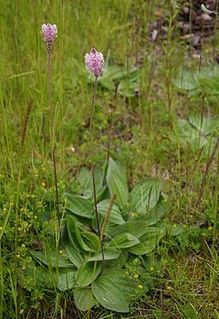
Plantago media, known as the hoary plantain, is a species of flowering plant in the plantain family Plantaginaceae. It is native to central and western Europe, including Great Britain and introduced to parts of the north-east United States. Its generic name is derived from the Latin for sole; like other members of the genus Plantago, it should not be confused with the unrelated plantain, a starchy banana.

Plantago maritima, the sea plantain, seaside plantain or goose tongue, is a species of flowering plant in the plantain family Plantaginaceae. It has a subcosmopolitan distribution in temperate and Arctic regions, native to most of Europe, northwest Africa, northern and central Asia, northern North America, and southern South America.

Alisma lanceolatum is a species of aquatic plant in the water plantain family known by the common names lanceleaf water plantain and narrow-leaved water plantain. It is widespread across Europe, North Africa and temperate Asia. It is naturalized in Australia, New Zealand, Oregon, California and British Columbia. It is considered a noxious weed in some places.

Plantago coronopus, the buck's-horn plantain, is a herbaceous annual to perennial flowering plant in the family Plantaginaceae. Other common names in the US and Italy include minutina and erba stella.
Plantago debilis is a species of herb native to Australia. Common names include shade plantain and weak plantain.
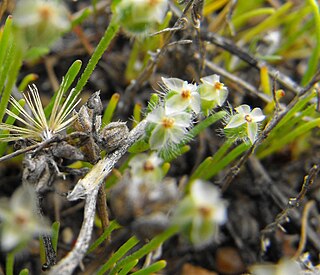
Plantago erecta, in the plantain family, is known variously as California plantain, foothill plantain, dot-seed plantain, English plantain, and dwarf plantain.

Plantago aristata is a species of plantain known by the common name bracted plantain or largebracted plantain. It is native to the eastern and central United States, and it can be found in other parts of North America as well as parts of Eurasia as an introduced species. It grows in many types of habitat, including disturbed areas, where it is a minor weed.

Plantago patagonica is a species of plantain known by the common name woolly plantain. It is native to much of North America, including the southern half of Canada, the western and central United States, and northern Mexico, and parts of southern South America. It grows in many types of habitat, including grassland and woodlands. It is a hairy annual herb producing linear or very narrowly lance-shaped basal leaves up to 10 centimetres (4 in) long. There are usually many stemlike inflorescences growing erect to a maximum height of around 15 cm (6 in). Atop the peduncle of the inflorescence is a dense cylindrical or somewhat conical spike of several tiny flowers and bracts. The spike is very woolly.
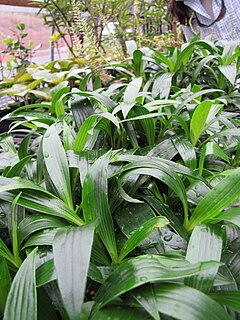
Plantago princeps is a rare species of flowering plant in the plantain family known by the common name ale. It is endemic to Hawaii, where it is known from the islands of Hawaii, Kauai, Oahu, Molokai, and Maui. Like other Hawaiian Plantago, it is known as kuahiwi laukahi, or laukahi kuahiwi. It is a federally listed endangered species of the United States.

Plantago rugelii is an edible species of flowering plant in the plantain family, Plantaginaceae. It is native to North America, where it occurs in eastern Canada and the central and eastern United States. Its common names include American plantain, blackseed plantain, pale plantain, and Rugel's plantain. The species name rugelii honors Ferdinand Ignatius Xavier Rugel (1806-1879), a German-born botanist and pharmacist.

Plantago cordata is a species of flowering plant in the plantain family known by the common name heartleaf plantain. It is native to eastern North America, where it is distributed throughout eastern Canada and the eastern United States. Though it has a wide distribution, it is very localized, and populations have declined almost everywhere.

Plantago hookeriana, commonly called Hookers plantain, is a species of flowering plant in the plantain family (Plantaginaceae). It is native to Texas and Louisiana in the United States. It is typically found in disturbed sandy areas.

Plantago rhodosperma is a species of flowering plant in the plantain family known by the common names redseed plantain and redseed indianwheat. It is native to the Great Plains and Southwest of the United States.
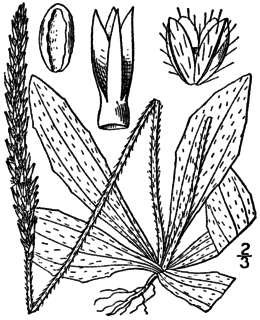
Plantago virginica, common names hoary plantain and Virginia plantain, is a plant found in North America introduced in Asia. It is listed as a special concern in Connecticut. The Kiowa use it to make garlands or wreaths for old men to wear around their heads during ceremonial dances as a symbol of health. It is commonly found within the continental United States in the majority of states along coastal areas and on roads, though has become an invasive species to eastern China after its introduction c. 1980. It is an annual plant, blooming around the month of May.
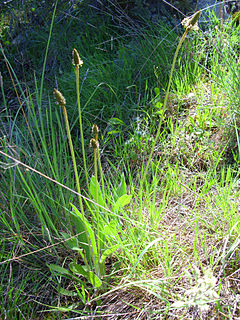
Plantago lagopus, the hare's foot plantain, is a species of annual herb in the family Plantaginaceae. They have a self-supporting growth form and simple, broad leaves. Flowers are visited by Heliotaurus ruficollis, Malachius, Metopoplax origani, and brown argus. Individuals can grow to 25 cm.



















